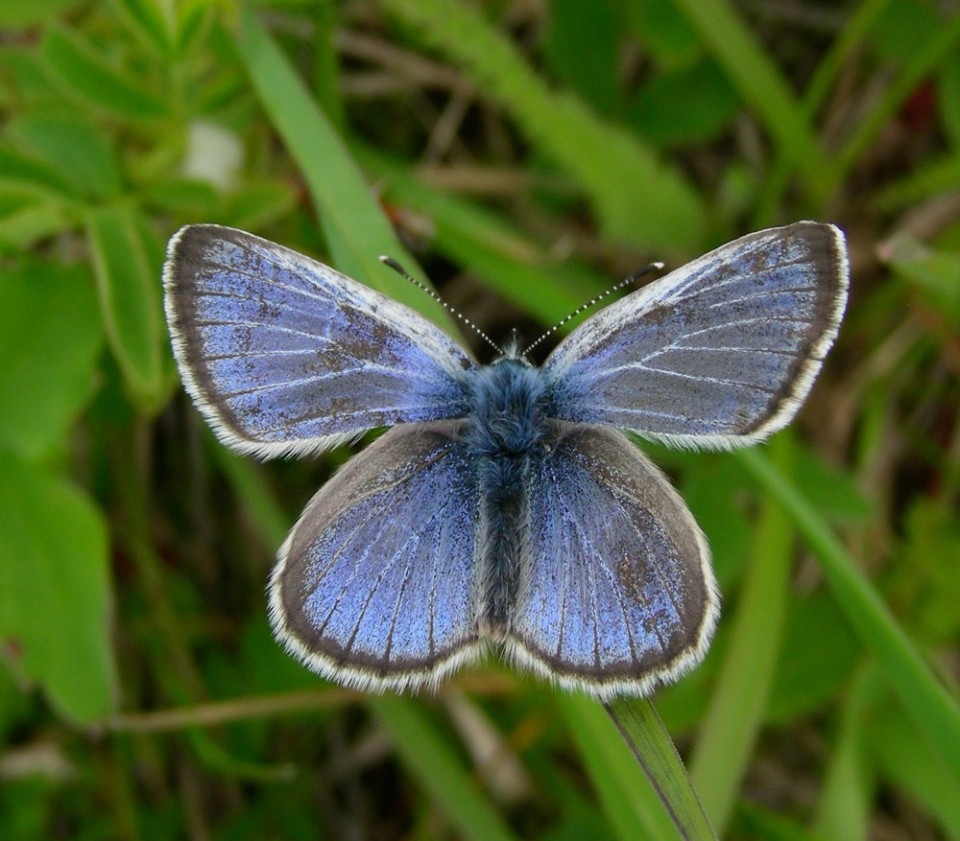One of our local Deep Green Resistance members spotted a stand of Kincaid’s Lupine, a federally listed threatened species, on a roadside in Lane County southeast of Eugene. This stand is located in an area where active road construction has been disturbing and destroying vegetation for the past several weeks. We are working to contact local conservation organizations, governmental agencies, and biologists, and neighbors to ensure that this stand is protected and allowed to grow.
Kincaid’s lupine is a perennial species in the pea or legume family (Fabaceae). With its low growing habit and unbranched flower stalk, Kincaid’s lupine is easily distinguished from other species of lupine. Its aromatic flowers have a slightly reflexed, distinctly ruffled banner and are yellowish-cream colored, often showing shades of blue on the keel. In the Willamette Valley, the flowers are often reddish-purple. The leaflets are deep green with a smooth upper surface. The plants are low-growing, 16-30 inches, with flowering stems that exceed the height of the branched crown. Flowering typically occurs in May and June. Seeds are dispersed from fruits that open explosively upon drying.
Habitat
Kincaid’s lupine is found mainly in the Willamette Valley, Oregon where it occupies native grassland habitats. Kincaid’s lupine is typically found in native upland prairie with the dominant species being red fescue (Festuca rubra) and/or Idaho fescue (Festuca idahoensis). Tolmie’s mariposa (Calochortus tolmiei),Hooker’s catchfly (Silene hookeri), broadpetal strawberry (Fragaria virginiana), rose checker-mallow (Sidalcea virgata), and common lomatium (Lomatium spp.) serve as herbaceous indicator species. These dry, fescue prairies make up the majority of habitat for Kincaid’s lupine. Although Kincaid’s lupine is occasionally found on steep, south-facing slopes and barren rocky cliffs, it does not appear capable of occupying the most xeric oatgrass communities on these south facing slopes. The plant’s distribution implies a close association with native upland prairie sites that are characterized by heavier soils and mesic to slightly xeric soil moisture levels. At the southern limit of its range, this species occurs on well-developed soils adjacent to serpentine outcrops (high in magnesium, iron and certain toxic metals) where the it is often found under scattered oaks.
Reasons for Decline
Native prairie has been virtually eliminated from the Willamette Valley as a result of conversion to agriculture, urbanization, and other development. Most Willamette Valley grasslands are seral (one stage in a sequential progression), requiring natural or human-induced disturbance for their maintenance. Grasslands by nature are a transient community which require disturbance to prevent transition to forest. The vast majority of Willamette Valley grasslands would be forested if left undisturbed. Native Americans probably maintained Willamette Valley prairies by manipulating fire regimes prior to European settlement. With extensive changes in the fire regime, disturbance forces that maintained native prairies were substantially altered allowing tree and shrub species to invade and shade out the low-growing Kincaid’s lupine. In addition, non-native species such as Himalayan blackberry (Rubus discolor) aggressively overtake open spaces and crowd out native species.
Loss of native prairie results in the separation of lupine populations which were once inter-connected. As the number of sites declines and the distance between them increases, the opportunities for dispersal of seeds between populations is reduced. Populations isolated in this manner face a higher chance of exterpation, since they are no longer part of a larger, more stable population.
Conservation Measures
Natural processes which functioned to maintain open grasslands have been altered to the point that intervention is needed to prevent further loss. Historically, large-scale fire played a role in maintaining grasslands in an open state. Today, grassland remnants are no longer maintained by fire due to suppression efforts. Where possible, controlled burning or careful mowing and hand clearing are used to manage grassland ecosystems. However, Kincaid’s lupine is host to the endangered Fender’s blue butterfly; thus, management actions have to be carefully planned in order to avoid harming the butterfly.
Range
Kincaid’s lupine occupies sites throughout the Willamette Valley, a few sites in the Umpqua River Basin, and one site in southern Washington. The northern limit of Kincaid’s lupine is Lewis County, Washington, and it ranges south to Douglas County, Oregon.
About Fender’s Blue Butterfly
This subspecies of the Boisduval’s blue butterfly (Icaricia icarioides) was believed to be extinct from 1937 until it was rediscovered in 1989. The distribution of this butterfly is restricted to the Willamette Valley, Oregon, where it currently occupies 32 sites in Yamhill, Polk, Benton, and Lane Counties. One population is found in wet, Deschampsia-type prairie, while all other remaining populations are found on drier, upland prairies characterized by Festuca (forage grasses) species. Sites occupied by Fender’s blue butterfly are located almost exclusively on the western side of the valley, within 33 kilometers (21 miles) of the Willamette River. The largest populations occur at Baskett Slough National Wildlife Refuge and at Willow Creek Main Preserve managed by The Nature Conservancy.






Good work!